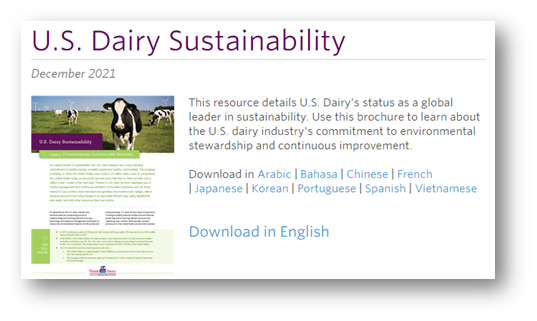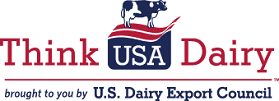-
Dairy’s Path to Greenhouse Gas Neutrality Featured at International Conferences
By USDEC Staff November 22, 2022- Tweet
The U.S. dairy community continues to make investments for the future of food. Thanks to dairy farmers’ relentless use of careful management and adoption of innovative practices, milk is being produced in the United States in an especially efficient way that nourishes people but also helps protect our planet. One example of this, U.S. Dairy’s bold journey to greenhouse gas (GHG) neutrality, was showcased at the International Union of Food Science and Technology (IUFoST) 21st World Congress of Food Science & Technology in Singapore early this month.


The theme of this year’s global conference was Future of Food: Innovation, Sustainability & Health. Dr. Frank Mitloehner, professor and air quality specialist at University of California-Davis, presented on The Path for Climate Neutrality in the Dairy Sector as part of a conference session on Pathways to Sustainable Nutrition: Consumer Voices and Dairy’s Journey. In particular, Dr. Mitloehner examined the distinctions of methane and carbon dioxide in warming the atmosphere, which is explained in the video Rethinking Methane. Dr. Mitloehner also addressed how dairy could contribute to global solutions to address climate change such as via methane reductions from feed additives.
For generations, the U.S. dairy community has implemented best farming practices and used technology and advanced management techniques to reduce the environmental footprint of milk production and processing. U.S. dairy farmers have a long history of being excellent stewards of their land and animals, protecting and conserving natural resources and optimizing cow comfort. Milk and dairy product processors in the United States are also fully invested in efforts to optimize water and energy use, reduce GHG emissions and turn waste into value.
Consider this sustainable supply chain:- The United States is a leader in global herd efficiency, producing four times more milk per cow than the average global cow. The nutrition in milk offers key nutrients essential to human health and U.S. suppliers offer a wide portfolio of high-quality ingredients that can be incorporated into local foods and cuisines to add value and enhance taste.
- To maximize nutrition, U.S. dairy cows eat a specially designed diet formulated to provide optimal nourishment while also providing benefits across the food chain. Cows’ ability to consume materials that humans can’t digest, like byproducts from food processing, such as citrus pulp and almond hulls, minimizes the waste associated with food production.
- Innovative practices such as installing anaerobic digesters on some U.S. dairy farms converts methane from manure and food waste into a source of renewable energy. The remaining liquid can be used as fertilizer for farm crops and remaining fiber can be used for animal bedding.

Adopting progressive farming practices like these contributed to a 2019 FAO report milestone. From 2005 to 2015, North America (where the U.S. is the primary dairy producer) was the only region in the world to increase milk production while also reducing absolute emissions, making its GHG intensity for dairy products the lowest in the world. Further reductions were measured in 2017 when the production of 1 gallon (3.8 liters) of milk involved 30% less water, 21% less land, and a 19% smaller carbon footprint than in 2007.
U.S. dairy’s key contributions to global climate and food security goals were also showcased at the United Nations Climate Change Conference (COP27) in Sharm el-Sheikh, Egypt this month. The U.S. Dairy Export Council supports major agricultural climate initiatives like Pathways to Dairy Net Zero, the Agriculture Innovation Mission for Climate, and the Coalition on Sustainable Productivity Growth for Food Security and Resource Conservation. Involvement in these organizations emphasizes U.S. dairy’s commitment to reduce its environmental impact further while continuing to fulfill the industry's critical role in a more sustainable global food system.
U.S. dairy ingredients are nutritious, functional and innovative solutions that nourish global consumers deliciously and sustainably. This passion across the supply chain positions U.S. Dairy to help food and beverage manufacturers worldwide capitalize on the growing demand for more nutritious and delicious products made from socially, environmentally, and economically responsible sources.Visit ThinkUSAdairy.org and follow our LinkedIn business page for further information on U.S. Dairy and inspiration for innovation.
Most Popular Posts
Find by Date, Geography and Dairy Product
- September 2015 (6)
- December 2015 (5)
- September 2016 (5)
- December 2016 (5)
- June 2017 (5)
- February 2015 (4)
- March 2015 (4)
- April 2015 (4)
- May 2015 (4)
- June 2015 (4)
- July 2015 (4)
- November 2015 (4)
- January 2016 (4)
- March 2016 (4)
- June 2016 (4)
- August 2016 (4)
- October 2016 (4)
- November 2016 (4)
- February 2017 (4)
- March 2017 (4)
- April 2017 (4)
- November 2013 (3)
- October 2015 (3)
- February 2016 (3)
- April 2016 (3)
- May 2016 (3)
- July 2016 (3)
- January 2017 (3)
- May 2017 (3)
- July 2017 (3)
- August 2017 (3)
- September 2017 (3)
- October 2014 (2)
- August 2015 (2)
- October 2017 (2)
- December 2017 (2)
- July 2020 (2)
- December 2013 (1)
- February 2014 (1)
- June 2014 (1)
- August 2014 (1)
- September 2014 (1)
- November 2014 (1)
- November 2017 (1)
- January 2018 (1)
- February 2018 (1)
- May 2018 (1)
- June 2018 (1)
- July 2018 (1)
- August 2018 (1)
- September 2018 (1)
- October 2018 (1)
- November 2018 (1)
- February 2019 (1)
- March 2019 (1)
- April 2019 (1)
- July 2019 (1)
- October 2019 (1)
- March 2020 (1)
- April 2020 (1)
- June 2020 (1)
- October 2020 (1)
- November 2020 (1)
- March 2021 (1)
- April 2021 (1)
- June 2021 (1)
- August 2021 (1)
- February 2022 (1)
- June 2022 (1)
- September 2022 (1)
- October 2022 (1)
- November 2022 (1)
- February 2023 (1)
- April 2023 (1)
- USDEC Staff (65)
- Kara McDonald (24)
- Terri Rexroat (15)
- John Klees (15)
- Kristi Saitama (9)
- Angelique Hollister (8)
- Vikki Nicholson-West (8)
- Shannon Koski (8)
- Rohit Kapoor (3)
- Keith Meyer (2)
- Moises Torres-Gonzalez (2)
- Amy Foor (2)
- Alan Levitt (1)
- Tom Vilsack, President and CEO (1)
- Allison Guzman (1)
- Dacia Whitsett-Morrow (1)
- Ryan Hopkin (1)
- Matthew Pikosky (1)
- Ross Christieson (1)
- Nina Halal (1)
- Mary Wilcox (1)
Keywords
- 2018 beverage trends (3)
- 2018 Food Innovations (1)
- 2018 food trends (3)
- Asia (1)
- Avian Influenza (1)
- Award-winning cheeses (3)
- Awards (2)
- Back-to-School (1)
- Baked Goods (1)
- Bakery (1)
- Beer (2)
- Beverage (5)
- Breakfast (1)
- Butter (6)
- Casein (2)
- Cheese (48)
- cheese flavors (2)
- Cheese Pairing (3)
- Cheesemaking (5)
- Child Nutrition (3)
- China (6)
- Clean Label (6)
- Common Food Names (1)
- Consistent Supply (3)
- Consumer Insights (48)
- Consumer Promotional Tools (1)
- Consumer Trends (15)
- Contest (1)
- craft foods (2)
- Cultured dairy (1)
- Dairy (17)
- Dairy Detective (4)
- Dairy Fat (1)
- Dairy Futures and Options (3)
- Dairy Ingredients (82)
- Dairy Ingredients Symposium (1)
- Dairy Permeate (1)
- Dairy Product Solids (1)
- Dairy Production (5)
- Dairy Proteins (35)
- Dairy Resources (23)
- Dairy Trade (1)
- Dairy Trends (10)
- Dessert (1)
- Digestive Health (2)
- Donna Berry (1)
- Drinkable yogurt (1)
- Early Childhood Development (1)
- Educational Tools (1)
- Egg Replacement (2)
- Egg Substitution (1)
- Egypt (1)
- Energy (4)
- Environment (2)
- Europe (1)
- Export Data (8)
- Exports (7)
- Farming (1)
- Flavor Trends (1)
- Follow-on Formula (1)
- Food Aid (2)
- Food and Beverage Trends (7)
- Food Production (3)
- Food Technology (3)
- Foodservice (2)
- Free From Claims (1)
- Full-fat Dairy (1)
- Geographical Indications (GIs) (1)
- GHG (1)
- Global (74)
- Global Dairy Market (2)
- Global Demand (2)
- Global Market (4)
- Global Supply (1)
- Greek Yogurt (1)
- Gulfood (2)
- Gut Health (1)
- Health (1)
- Healthy Aging (8)
- Healthy Indulgence (1)
- Heavy Cream (1)
- High Quality Protein (11)
- Holiday Dessert (2)
- Holidays (1)
- IFT (7)
- IFT2016 (1)
- IFT2018 (2)
- Infant Formula (1)
- Infographic (3)
- Innova Market Insights (4)
- Innovation (2)
- Japan (7)
- Lactose (8)
- Lactose-free (1)
- LinkedIn (1)
- Malnutrition (2)
- Market Insights (67)
- Methane (1)
- Mexico (2)
- Micellar Casein (3)
- Middle East (2)
- Middle East/North Africa (9)
- Milk (8)
- Milk Permeate (2)
- Milk Powder (10)
- Milk Protein (19)
- Milkfat (5)
- Millennials (3)
- MPC (4)
- MPI (1)
- Muscle Maintenance (1)
- Muscle Recovery (2)
- Muscle Synthesis (2)
- NAFTA (1)
- New Product Introductions (1)
- New Year's Resolutions (1)
- Nonfat Dry Milk/Skim Milk Powder (4)
- Nutrition (21)
- Nutrition Research (14)
- Obesity (1)
- Overnutrition (1)
- Permeate (19)
- Price Volatility (2)
- Probiotics (2)
- Product Innovation (3)
- Protein (33)
- Prototypes (1)
- Record (3)
- Reduced-Fat (1)
- Research & Data (1)
- Resources and Tools (8)
- Risk Management (3)
- RTD Coffee and Tea (1)
- Salon Culinaire (1)
- Salt Substitute (1)
- Savory Flavors (1)
- Science and Research (3)
- Service Providers (1)
- Simple Ingredients (1)
- Singapore (1)
- Skimmed Milk Powder (2)
- Smoothies (1)
- Snack Trends (3)
- Snacking (4)
- Snacks (1)
- Sodium (3)
- Sodium Reduction (4)
- South Korea (3)
- Southeast Asia (9)
- Sports Nutrition (4)
- Stewardship (1)
- Student Competition (1)
- Supplier Directory (1)
- Supply (4)
- Sustainability (7)
- Sustainability Awards (1)
- Sustainable Nutrition (7)
- Technology (1)
- ThinkUSAdairy (2)
- Toddler Formula (1)
- Trade Data (1)
- U.S. Dairy Industry (11)
- U.S. Dairy Industry Growth (6)
- U.S. Dairy Partnerships (4)
- U.S. Dairy Products (15)
- UK (1)
- United Arab Emirates (5)
- United States (10)
- USDEC Events (44)
- Value (3)
- Vietnam (5)
- Volatility (1)
- Volume (4)
- Waste Reduction (1)
- Weight Management (6)
- Whey (14)
- Whey Ingredients (3)
- Whey Permeate (5)
- Whey Products (3)
- Whey Protein (47)
- Whey Protein Concentrate (3)
- Whey Protein Isolate (5)
- Whole-milk dairy (1)
- Wine (2)
- World Championship Cheese Contest (1)
- World Cheese Awards (2)
- World Milk Day (1)
- WPC (4)
- WPI (1)
- Yogurt (6)


